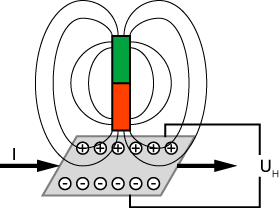Hall sensor
If a current flows through a Hall sensor, and the Hall sensor is brought into a magnetic field running vertically to it, the sensor supplies an output voltage that is proportional to the product of the magnetic field strength and current (Hall effect).
The amplitude of the induced voltage UH is a sine function dependent on the position to the magnetic field. The Hall sensor generates one sine period per pole pair.
A Hall sensor also supplies a signal when the magnetic field in which it is located is constant. This is the decisive advantage compared to a sensor that consists of magnet and coil. As soon as magnet and coil in this pairing are not moved against each other, the voltage induced in the coil is zero and the magnet is not detected.
The position of the rotor cannot be uniquely determined with a single sine signal. Two sensors, electrically offset by 90° are used that generate a sine and a cosine signal. Through evaluation of both signals, the rotor position and direction of rotation can be uniquely determined.

The following signal pattern results with one period per rotation:

